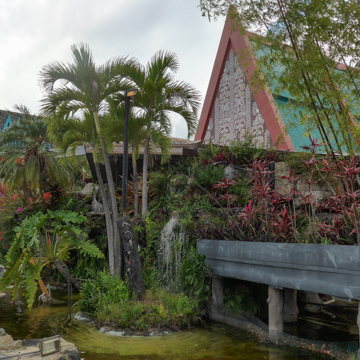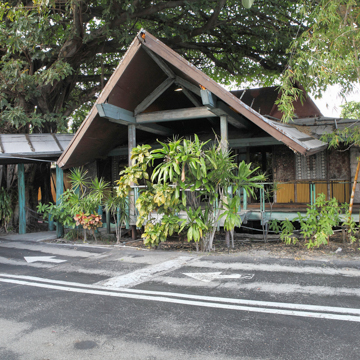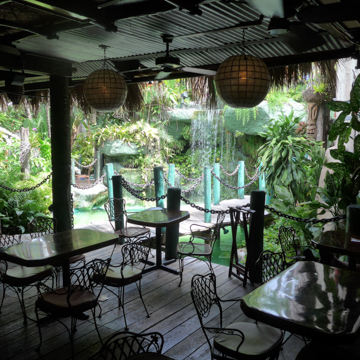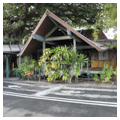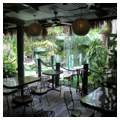Starting with the 1915 Panama–Pacific International Exposition in San Francisco and followed by World War II and the Korean War, by midcentury the American public was increasingly drawn toward a fascination with Polynesia as a place of exotic, and often erotic, fantasy. This movement, sometimes referred to as the “Polynesian Pop” or “Tiki” era, appeared in American restaurant culture beginning in the 1930s with the opening of Don the Beachcomber in Hollywood, California, the first Polynesian-themed restaurant in the United States and the reputed home of a potent cocktail called the Zombie. Supported by South Pacific, the enormously popular Broadway musical of 1949 and film of 1958, and by the statehood of Hawaii in 1959, this interest in Pacific architecture, culture, cuisine, and art was manifested most prominently in South Florida in Mai-Kai, a Polynesian-themed restaurant just outside the tropical resort community of Fort Lauderdale and one of the few intact examples of this type of architecture remaining in the United States. South Florida was a logical location for American fantasies of Polynesian tropical lushness. Fort Lauderdale is closely connected to the warm waters of the Atlantic and has a year-round subtropical warm environment that supports the growth of tropical plants.
Mai-Kai opened in 1956 on the west side of North Federal Highway. The original restaurant was basically a one-story, U-shaped plan with a tropical garden in the center running east-west toward the lush landscape to the east along the highway. The restaurant featured the integration of tropical landscape and sculpted tikis, and patrons were served Polynesian-themed cocktails and food. The prominent open, A-frame structure hovering over the lush roadside landscape provided signage that promised the orientalized Polynesian Pop interiors within. By the early 1960s, the neighborhood around Mai-Kai became more developed as Fort Lauderdale rose in popularity as a winter resort, due in part to the film Where the Boys Are (1960).
Florida, like California, was already the home of several Polynesian-themed restaurants that provided a context for the opening of Mai-Kai. Coral Gables had Tahiti Beach since the 1920s and Sarasota boasted the famed Bahi Hut (1954). Perhaps the most famous Polynesian-themed restaurant in the region was The Castaways (1957) on Miami Beach, which was joined by the Hawaiian Inn in Daytona Beach, the Volcano Polynesian Restaurant in Winter Haven, and the Tiki Gardens in Indian Rocks Beach, all from the 1960s.
Success brought new needs to Mai-Kai. By 1960, the first set of modifications were complete: a new porte-cochere was built, the bar was enlarged to the east of the arrival area, and a portion of the central garden area was covered so that floor shows, which now run two per evening and feature Polynesian dancers, could be added to the dining experience. In 1971, a large wing was added to the southern portion of the project; it included a kitchen and a covered terrace known as the Lanai that opened to the gardens along the south of the building.
Despite these changes over the years, the original connections between landscape, the Polynesian-themed building structure and materiality, and Tiki-styled art objects and cocktails remains entirely intact. In fact, the original cocktail menu featured more than a dozen specialty cocktails that were registered with trademarks from the time of the restaurant’s opening. While the menu is now largely based upon Thai and Chinese cuisine, it is still fairly close to the original menu that followed one popularized at Trader Vic’s in Oakland, California, where the first example of “Polynesian” cuisine was presented as Chinese dishes enhanced with bananas, pineapple, and coconut to create a new kind of sweet and exotic cuisine acceptable to the American palate.
Upon entering Mai-Kai the visitor is treated to an elaborately decorated wood-paneled interior. The nautical-themed Molokai bar opens to the left of the entrance and evokes, with its hanging ropes and a carved wooden figurehead, a passage overseas to a distant land. Low-slung windows look out onto a lush landscape that is partially obscured by water streaming from fountains down the outer face. Straight ahead of the entry is the Tonga Room, located under the A-frame room, where the stage is located on the left side and tables are situated on a series of terraced levels. Musical instruments, preserved birds in cages, and other decorative items float within the rafters.
Either before or after dinner, visitors are encouraged to walk through the compact lush tropical gardens that feature numerous illuminated tikis, lit torches, waterfalls, streams, and bridges that start within the building at various locations and extend outside. In a way unique to subtropical and humid South Florida, the Polynesian-theme, tikis, food, entertainment, cocktails, and landscape join to create an architectural experience that references geographies near and far, interests present and historical, and the perception of reality and fantasy in equal parts.
References
Avdakov, Steven, et al., “Mai Kai Restaurant,” Broward County, Florida. National Register of Historic Places Registration Form, 2014. National Park Service, U.S. Department of the Interior, Washington, D.C.

